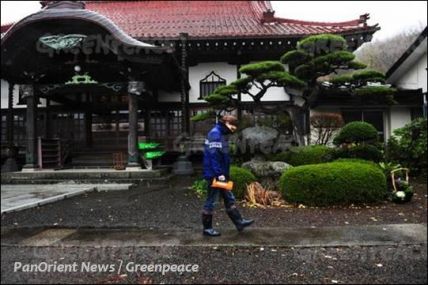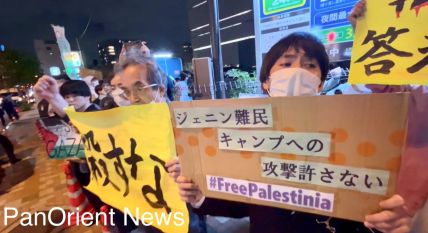|
|
Environment
Greenpeace: Relocation of Pregnant Women and Children Exposed to Radiation Vital
Thursday, December 8, 2011

Tokyo- (PanOrient News) Greenpeace renewed its demand to the Japanese government to urgently relocate pregnant women and children living in contaminated areas of Fukushima City due to the discovery of radioactive hot spots and accused the official decontamination program as being "both uncoordinated and thoroughly inadequate."
A statement by the independent global campaigning organization said that it’s recent radiation monitoring operation in the Watari and Onami neighborhoods of Fukushima City, roughly 60km from the stricken Fukushima nuclear plant has uncovered hot spots of up to 37 microSieverts per hour in a garden in suburban Watari, and 10.1 microSieverts per hour in bags of dirt, seemingly abandoned, on a road in Onami.
Greenpeace mapping of Watari shows that people are at risk of being exposed to over ten times the 1 milliSievert per year set by international standards as maximum for radiation levels.
The Greenpeace radiation experts found that contamination levels in the Fukushima neighborhoods were comparable to areas designated as evacuation zones, such as Minamisoma. Despite this, authorities have decided only to decontaminate the Fukushima City communities, without giving the residents the right to relocate - including pregnant women and small children, who are at the most risk
"The people of Onami and Watari are facing clear risks to their health and must be given the right to relocate with full support", said Kazue Suzuki, Greenpeace Japan Nuclear Campaigner. "At very least pregnant women and children must be evacuated from risky areas until sufficient decontamination is completed."
According to Greenpeace, Fukushima City levels for decontamination are 2 microSievert per hour at 1m for households with children or pregnant women, and 2.5 microSievert per hour at 1m for other households. Minamisoma levels for evacuation are 2 microSievert per hour at 50cm for households with children or pregnant women.
Although official decontamination work has been underway in Onami for two months, only 35 houses out of 370 have reportedly been completed to date, with residents continually exposed to radiation as they wait, Greenpeace said.
In the Watari area, no decontamination work has yet started, and official radiation monitoring is limited to just 1038 houses out of 6700. Worried residents wanting rapid decontamination are being left to do the work themselves without clear information about the risks or safety training – further threatening public health.
In August 2011, Greenpeace called on the authorities to urgently organize and deploy thousands of workers to decontaminated areas such as Fukushima City and Koriama, and presented new Prime Minister Yoshihiro Noda with a detailed list of technical demands (3). However, these demands have not been met, and the situation for many residents has clearly worsened since then.
Greenpeace provided examples of bad decontamination practices such as decontamination waste (top soil) of one house in Onami buried in an opposite field, risking further contamination spread, and decontamination run-off water with levels up to 9.8 microSv per hour at 10 cm on the street in Onami consequently, the contamination spreads throughout the environment.
Bags with decontamination waste left on a street in Onami with levels up to 10.1 microSievert/h at 10 cm, and inhabitants of Watari are asked to decontaminate their own houses. One resident buried waste in a corner of his garden only one meter away from the house. Radiation levels at that spot were 1.1 microSiever/h at 1 meter, according to Greenpeace.
"Radioactive waste is being buried on the same properties it is removed from, as there are still no proper waste storage sites, and decontamination work is spreading contamination rather than removing it," said Ike Teuling, Greenpeace International Radiation Expert.
"The situation is rapidly spinning out of control, and the Japanese government seems to have abandoned its responsibility to protect its population as it has left local authorities, who lack the necessary knowledge and equipment, to clean up this mess."
Photo: Greenpeace radiation monitoring team member Ike Teuling checks radiation levels in a temple in Watari, approximately 60km from the Fukushima Daiichi nuclear plant.
PanOrient News
© PanOrient News All Rights Reserved.
|
|

